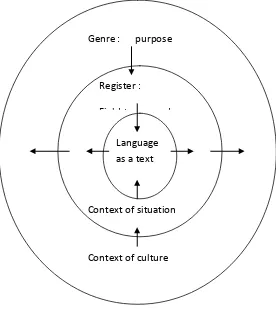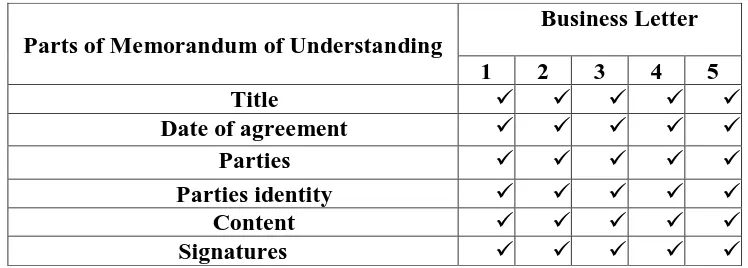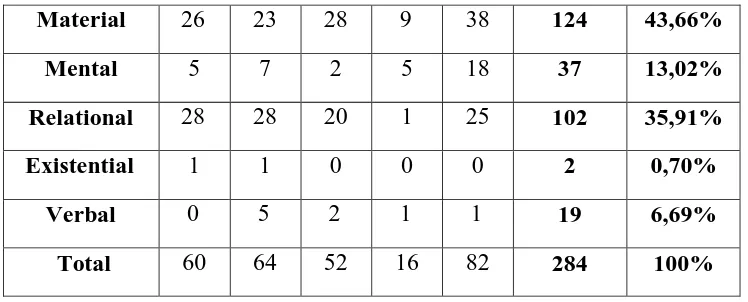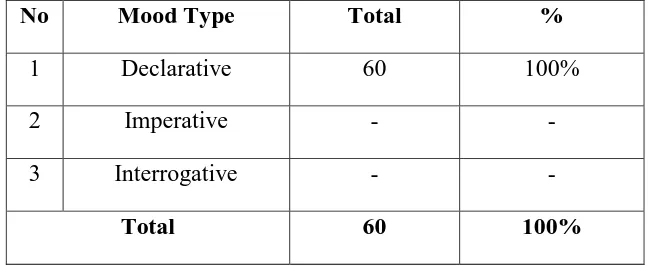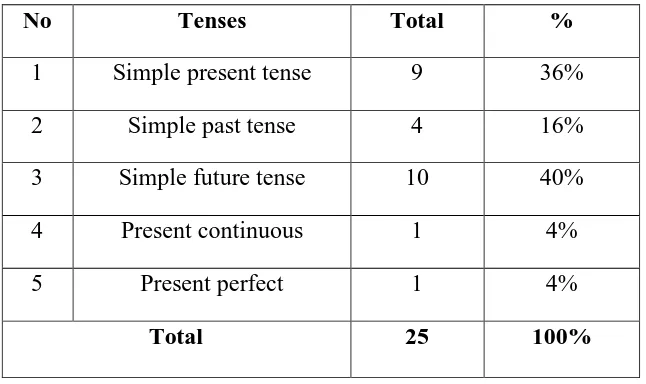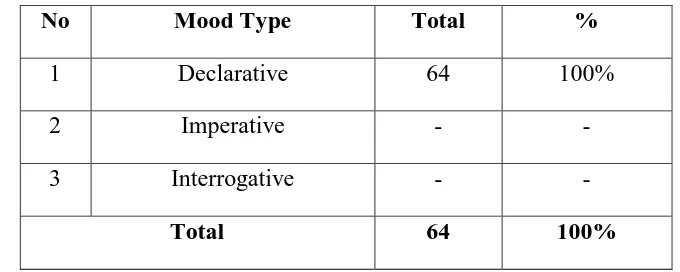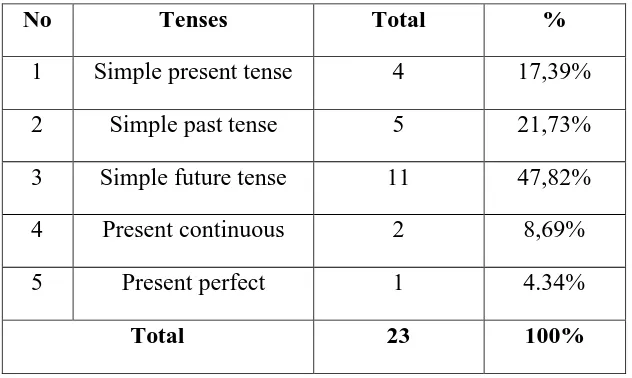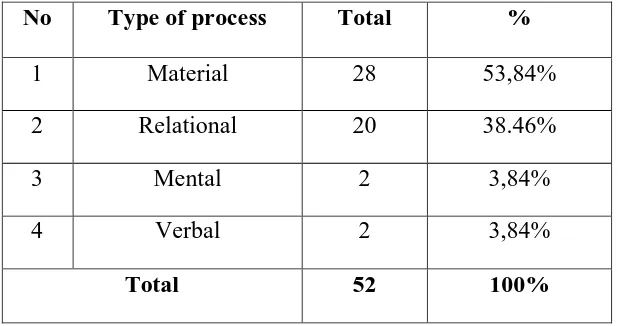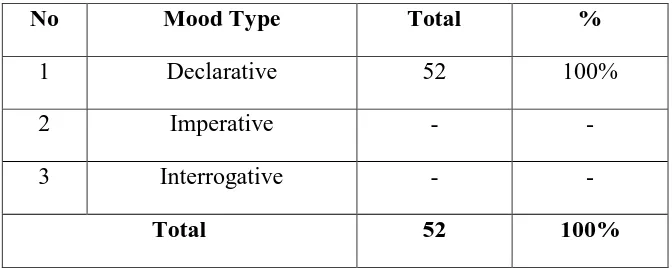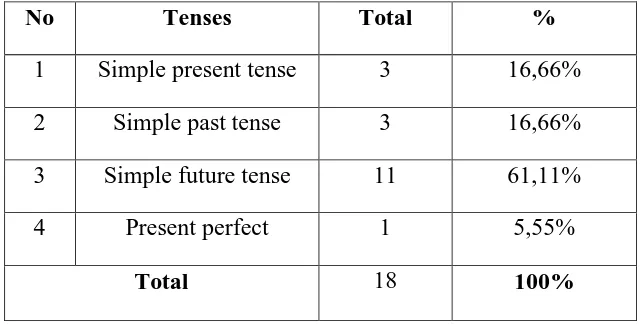i
GENRE ANALYSIS OF MEMORANDUM OF
UNDERSTANDING (MOU)
THESIS
Submitted in Partial Fulfillment of the Requirements for the Degree of Sarjana Sastra (S.S.)
In English Language
by:
MUHAMMAD MASHURI C11.2008.00977
ENGLISH DEPARTMENT, FACULTY OF HUMANITIES
DIAN NUSWANTORO UNIVERSITY
ii
THE ADVISOR APPROVAL
This thesis has been approved by Advisor, Strata 1 Study Program of English Department, Faculty of Humanities, Dian Nuswantoro University on February 28th, 2013.
Advisor
iii
PAGE OF APPROVAL
This thesis has been approved by Board of Examiners, Strata 1 Study Program of English Language, Faculty of Humanities, Dian Nuswantoro University on February 28th, 2013.
Board of Examiners
Chairperson First Examiner
Sunardi, S.S., M.Pd. Achmad Basari, S.S., M.Pd.
Second Examiner Adviser as Third Examiner
Setyo Prasiyanto C.,S.S., M.Pd. Dra.Sri Mulatsih, M.Pd.
Approved by:
Dean of
Faculty of Humanities
iv
STATEMENT OF ORIGINALITY
I hereby certify that this thesis is absolutely my own work. I am completely responsible for the contain of this thesis. Opinions or findings of others are quoted and cited with respect to ethical standard.
Semarang, February 28th, 2013
v
MOTTO
1. There is no God but Allah. (AlQur‟an) 2. No pain, no gain.
vi
DEDICATION
I dedicate this thesis especially to:
1. My beloved Mom and Dad with their endless love, tears, and a lot of prayer for me.
2. My brother: Mas Zainodin, and Mashudi; my sister: Mbak Atik who always supported me.
3. My little Sweetest niece Latifa Zalfa Puspitasari who always made me enjoyed during finishing this thesis.
vii
ACKNOWLEDGEMENT
At this great moment, I wish a prayer to Allah SWT who has blessed and Guided me during the writing of this thesis.
On this occasion, I would like to express my sincere gratitude to:
1. Dean of Faculty of Humanities of Dian Nuswantoro University, Mr. Achmad Basari, S.S., M.Pd., who gave me permission to conduct this study;
2. Mr. Sarif Syamsu Rizal, S.S., M.Hum., Head of English Department of Strata 1 Study Program, Faculty of Humanities of Dian Nuswantoro University, who gave me permission to conduct this research and also guided me with encouragement, advice, patience, ideas, motivation in completing this thesis . 3. Mrs. Dra.Sri Mulatsih, M.Pd., my adviser, who also guided me with kindness,
advice, patience, ideas and big responsibility in completing this thesis;
4. All lecturers at the English Department of Humanities of Dian Nuswantoro University, who have taught, motivated, and given guidance during the writing of this thesis;
5. All staff of administration of English Department of Faculty of Humanities of Dian Nuswantoro University, who always helped me during my study,
6. The librarians of Dian Nuswantoro University Central Library for their permission to use some valuable references in writing this thesis;
viii
8. My family in Pati who always support and pray for me to accomplish this thesis;
9. All my friend “Korean Guys”, Didot, Japrak, Pomponk, Jarko, Tidar, Anil, Babon, MJ, Bom2, Abid, Dipo, Nasoka, Danang, Brodjol, Andi Mz Tri, Mz Eko Alim, Anas, and Boncel thank you for your support Guys;
10. All of my friends at English Department, Faculty of Humanities, Dian Nuswantoro University and All of my friends in this world, that I can not mention one by one;
11. The last but not least, all people whom I cannot mention who helped me in finishing this thesis, thank you very much.
Finally, I do realize that due to my limited ability, this thesis must have shortcomings and is far from being perfect. For this, I do welcome any suggestions and criticisms.
Semarang, February 28th, 2013
ix
TABLE OF CONTENTS
PAGE OF TITLE ... i
THE ADVISOR APPROVAL ... ii
PAGE OF APPROVAL ... iii
STATEMENT OF ORIGINALITY ... iv
MOTTO ... v
DEDICATION ... vi
ACKNOWLEDGEMENT ... vii
TABLE OF CONTENTS ... ix
LIST OF FIGURE ... xvi
LIST OF TABLE ... xvii
ABSTRACT ... xviii
CHAPTER I INTRODUCTION ... 1
1.1 Background of the Study... 1
1.2 Statement of the Problem ... 4
1.3 Scope of the Study ... 4
1.4 Objective of the Study... 5
1.5 Significance of the Study ... 5
1.6 Thesis Organization ... 6
CHAPTER II REVIEW OF RELATED LITERATURE ... 7
2.1 Language ... 7
x
2.3 Text and Context ... 8
2.4 Context of Culture ... 10
2.5 Text Type ... 17
2.6 Letter ... 30
2.6.1 Definition of Letter ... 30
2.6.1.1 Business Letter ... 31
2.6.2 Memorandum of Understanding ... 32
2.6.2.1 Definition MOU ... 32
2.6.2.2 Characteristic of MOU ... 34
CHAPTER III RESEARCH METHOD... 40
3.1 Research Design ... 40
3.2 Unit of Analysis ... 40
3.3 Source of Data ... 41
3.4 Technique of Data Collection ... 41
3.5 Technique of Data Analysis ... 41
CHAPTER IV DATA ANALYSIS ... 43
4.1 The findings of MOU letter ... 43
4.2 The discussion of first MOU between UDINUS and MMU ... 48
4.2.1 Social function of first MOU ... 48
4.2.2 Schematic structure of first MOU ... 49
1. Title ... 49
xi
3. Parties ... 50
4. Parties identity ... 50
5. Content ... 51
5.1 Scope of understanding………... 52
5.2 Contact persons……… 53
5.3 Mutual expense and reliance……… 53
5.4 Confidentiality……… 53
5.5 Implementation and termination……….. 54
5.6 Limitation of liability………. 55
5.7 Modifications……….. 55
5.8 Governing law and jurisdiction………… 55
6. Signatures……….. 56
4.2.3 Linguistic Features of first MOU ... 57
4.2.3.1Process ... 57
4.2.3.2 Mood Types ... 61
4.2.3.2Tenses ... 62
4.3 The discussion of second MOU between UDINUS and UCI ... 65
4.3.1 Social Function of second MOU ... 65
4.3.2 Schematic Structure of second MOU ... 65
1. Title ... 65
2. Date of agreement ... 66
xii
4. Parties identity ... 67
5. Content ... 68
5.1 Scope of understanding………... 68
5.2 Contact persons ... 69
5.3 Mutual expense and reliance……… .... 70
5.4 Confidentiality……… 70
5.5 Implementation and termination ... 71
5.6 Limitation of liability ... 71
5.7 Modifications………. 72
5.8 Governing law and jurisdiction… ... 72
6. Signatures ... 73
4.3.3 Linguistic Features of second MOU ... 74
4.2.3.1 Process ... 74
4.2.3.2Mood Types ... 78
4.2.3.3 Tenses ... 79
4.4 The discussion of Third MOU between UDINUS and UTeM ... 82
4.4.1 Social Function of Third MOU ... 82
4.4.2 Schematic Structure of Third MOU ... 82
1. Title ... 82
2. Date of agreement ... 83
3. Parties ... 83
xiii
5. Content ... 85
5.1 Objective ... 85
5.2 Areas co-operation ... 86
5.3 Financial arrangement ... 87
5.4 Effect of MOU ... 87
5.5 No agency ... 88
5.6 Entry into effect and duration... 88
5.7 Notice ... 89
6. Signatures ... 89
4.4.3 Linguistic Features of Third MOU ... 90
4.3.3.1 Process ... 90
4.3.3.2 Mood Types ... 93
4. 3.3.3Tenses ... 94
4.5 The discussion of fourth MOU between UDINUS and CYCU. ... 97
4.5.1Social Function of fourth MOU ... 97
4.5.2 Schematic Structure of fourth MOU ... 97
1. Title ... 97
2. Parties ... 98
3. Parties identity ... 98
4. Content ... 99
xiv
4.2 Exchange of academic materials and academic
publications ... 100
4.3 Exchange of faculty members for research, lecturer, discussion ... 100
4.4 Exchange of graduate and undergraduate students for study and research ... 100
4.5 Linkage of website onto the sister university‟s website to enhance information exchange . 100
5. Signature ... 101
6. Date of agreement ... 101
4.5.3 Linguistic Features of fourth MOU ... 102
4.5.3.1 Process ... 102
4.5.3.2 Mood Types ... 105
4.5.3.3 Tenses ... 106
4.6 The discussion fifth MOU between UDINUS and UOM 108 4.6.1 Social Function fifth MOU ... 108
4.6.2 Schematic Structure fifth MOU ... 108
1. Title ... 108
2. Parties ... 109
3. Parties identity ... 109
4. Content ... 110
4.1 Scope and fields of academic cooperation.. 110
xv
4.3 Joint property………... 112
4.4 Confidentiality……….. ... 112
4.6 Notice……… ... 114
4.7 Miscellaneous……… ... 114
5. Signature ... 115
6. Date of agreements………. ... 116
4.6.3 Linguistic Features fifth MOU ... 117
4.5.3.1 Process ... 117
4.5.3.2 Mood Types ... 120
4.5.3.3Tenses ... 121
CHAPTER V CONCLUSION AND SUGGESTION ... 123
5.1 Conclusion... 123
5.2 Suggestion ... 124
BIBLIOGRAPHY ... 125
xvi
LIST OF FIGURE
xvii
LIST OF TABLE
Table 2.1 Text Type and Communicative Purpose ... 18
Table 4.1 Part of MOU... 45
Table 4.2 Process type MOU ... 46
Table 4.3 Classifiying Tenses ... 47
Table 4.4 Process found of first MOU between UDINUS and MMU. ... 57
Table 4.5 Mood type found of first MOU between UDINUS and MMU... 61
Table 4.6 Tenses found of first MOU between UDINUS and MMU. ... 62
Table 4.7 Process found of second MOU between UDINUS and UCI. ... 74
Table 4.8 Mood type found of second MOU between UDINUS and UCI .... 78
Table 4.9 Tenses found of second MOU between UDINUS and UCI ... 79
Table 4.10 Process found of third MOU between UDINUS and UTeM. ... 90
Table 4.11 Mood type found of third MOU between UDINUS and UTeM. . 93
Table 4.12 Tenses found of third MOU between UDINUS and UTeM ... 94
Table 4.13 Process found of fourth MOU between UDINUS and CYCU .... 102
Table 4.14 Mood type found of fourth MOU between UDINUS and CYCU 105 Table 4.15 Tenses found of fourth MOU between UDINUS and CYCU ... 106
Table 4. 16 Process found of fifth MOU between UDINUS and UOM ... 117
Table 4.17 Mood types found of fifth MOU between UDINUS and UOM .. 120
xviii ABSTRACT
This thesis presents Genre Analysis of English Memorandum of Understanding made by Dian Nuswantoro University Semarang during 2007 – 2011. It analyzes the social function, schematic structure, and linguistic features on Dian Nuswantoro University Semarang.
The data were analyzed using descriptive method. The researcher followed some steps to analyze data, namely: reading the memorandum of understanding, segmenting into each clause, describing the social function of the memorandum of understanding, classifying the schematic structure, describing linguistics features and finally concluding the characteristics of the text.
The results of the analysis on memorandum of understanding made by Dian Nuswantoro University Semarang shows that out of five memorandum of understanding, The social function on memorandum of understanding is to inform and to describe an agreement between parties with several terms conditions, the different lies only on the scope of the program. The schematic structure on memorandum of understanding found in UDINUS the same that is Title ^ Date of agreement ^ Parties ^ Parties identity ^ Content ^ Signatures.
1
CHAPTER I
INTRODUCTION
1.1 Background of the Study
Language as means of communication occurs in daily activity as a text. Macken (1990: 6) state language is used in everyday life occurs as text. This is true in any spoken and written language. Based on the theory above people can communicate their idea, concept or feeling and changing information each other when they communicate.
Language represents medium of most communication comprehended by people in the entire world. Language as medium of communications has two types, there are written and spoken. Spoken language can be realized in oration, dialogue, and presentation. Meanwhile, written language can be realized in letter, news, short message, short story, and novel. Spoken language means that language which is expressed in speaking whereas, written language is the language expressed in writing. Communication in written language as people know is a text.
The term text is a way of talking about any meaningful piece of language, which is made coherent by the social context in which it is produced. A text can be as long as novel or as short as a traffic warning. Both texts have meaning, coherence, unity, and social purpose. Study about text means study about context of a text that is genre.
2
uses language to respond and to recur situations. Studies of genre also stress a concern with context as well as form and emphasize the importance of description and analysis rather than simple classification. It is also true that genre has become a key concept in modern thought, not only in linguistics and language teaching but in many areas of contemporary social and cultural studies. This is because language is seen as a central way in which people construct our lives. It is through genre that individuals develop relationship, establish communities, and achieve their goals. Without the familiar structure that gives to social events, it would be unable to conduct the most basic interactions of everyday life. Genres are more than forms (Sony, 2009: 2). It functions as frames for the way it acts, the thoughts it has, and the interactions it engages in.
Genre remains of fuzzy concepts, some what loose term of art (Hymes, 1974: 61) “Genre often coincides with speech events, but must be treated as analytically of independent of them”. They may occur in different events. Like, the sermon as a genre is typically identified with a certain place in a church service, humorous effect, in other situations. This is in accordance with Martin‟s statement (1986: 86) “Genres have complementary registers and communicative success with texts may require an appropriate relationship to system of genre of register”. Based on
this, the researcher move into a more confident exploitation of the genre.
3
memorandum of understanding. Memorandum of understanding will be found when people make an agreement and tied both of subject agreement with duty and right, memorandum of understanding is should be make a good result for both of subject agreement.
Memorandum of understanding is an arrangement of understanding between two or more parties as to a course of action; a covenant or treaty (Webster Comprehensive Dictionary, 2003:29). The most important thing in memorandum of understanding is there are two people who want to make a deal and the purpose to achieve a memorandum of understanding deal between two parties. In this research, the researcher chooses memorandum of understanding because the researcher wants to know how the memorandum of understanding is realized through the language especially connected to the genre. Memorandum of understanding is an implied agreement resulting from the express term of another agreement, whether written or oral to serve as the basis of future formal contract.
4 1.2.Statements of the Problems
The statements of the problem this study are:
1. What are the social functions of the memorandum of understandings made by Dian Nuswantoro University Semarang during 2007 – 2011?
2. What are the schematic structures of the memorandum of understandings made by Dian Nuswantoro University Semarang during 2007 – 2011?
3. What are the linguistic features of the memorandum of understandings made by Dian Nuswantoro University Semarang during 2007- 2011?
1.3 Scope of the Study
The scope of this study is genre analysis in the memorandum of understanding made by “Dian Nuswantoro University Semarang” between
5 1.4 Objectives of the Study
In the correlation of the statement of the problem, the objectives of the study are: 1. To describe the social function of the memorandum of understanding made by
Dian Nuswantoro University Semarang during 2007 – 2011?
2. To describe the schematic structure of the memorandum of understanding made by Dian Nuswantoro University Semarang during 2007 – 2011?
3. To describe the linguistic features of the memorandum of understanding made by Dian Nuswantoro University Semarang during 2007 – 2011?
1.5 Significances of the Study
The results of the study are expected to be a useful research for: 1. The researcher
To add more knowledge about discourse study especially on genre analysis. 2. The readers
As an additional reference that may be useful for the readers who are going to study about genre.
3. Anybody who reads this thesis proposal and interested in studying discourse especially about genre analysis of the memorandum of understanding.
6 1.6 Thesis Organization
This thesis is arranged in five chapters. The first chapter is introduction. It consists of background of the study, statement of the problem, scope of the study, objective of the study, significance of the study, and thesis organization.
Review of related literature is exposed in the second chapter. This chapter is arranged to support and direct the researcher in analyzing the data of the problem. The theories used in this chapter are: text, text and context, context of culture (genre), text type, memorandum of understanding.
The third chapter is research method that begins with the method used in this research. This chapter contains five sub-chapters: research design, unit of analysis, source of data, technique of data collection, technique of data analysis.
The next chapter is the fourth chapter. This chapter covers the Data Analysis. It presents research finding and discussion.
7
CHAPTER II
REVIEW OF RELATED
LITERATURETo make a good analysis, the researcher must be supported by several related theories. The theories which are applied in this thesis are text, text and context, context of culture (genre), text type, memorandum of understanding , Written memorandum of understanding, memorandum of understanding items. For further explanation of each theory can be seen in the following sub chapter below:
2.1 Language
Language is vowel symbol system which arbiter enabling every body a certain culture, or the others learning that culture system, communicating or has the interaction. (Finacchiaro, 1964 : 8).This definition has several important terms, each of which is examined in some detail. Those terms are system, signs, vocal, conventional, human, communicate.
The researcher use language as a means of communication. It has possession more than any other attribute, distinguishes humans from animals. To understand our humanity one must understand the language that makes us human. So, language is very important for human.
In communicating, human beings use two kinds of language, namely spoken and written languages. Spoken language is utterance in the form of sound, such as conversation, speech, storytelling, etc, while written language is utterance in the form of text (Halliday and Hasan 1976:2).
8
The word text is related to “textile” and can be translated as “fabric” just a single
threads form a fabric, so words and sentences form a meaningful and coherent text (Klarer,1991:1). Based on the statement on Klarer, when the text is coherent for the readers and addresses in this way, it is a discourse. A text is realized in knowable context. The context is not a product of either the conscious or unconscious intention of an author; nor its centrality and autonomy evident. The text is always produced in relation to something other. There are, in fact, raw materials of literature which form the necessary base from which it is produced.
People live in a world of words, when these words are put together to communicate of meaning, a piece of text is created. When you speak or write to communicate a message, you are constructing a text. When you read, listen to, or view a piece of text, you are interpreting its meaning creating a text requires us to make choice about the words people use and how people put them together. If people make the right choice than people can communicates with others. Our choice of words will depend on our purpose and our context. So, the important thing about text is an understanding meaning which appropriate to its context.
2.3 Text and Context
Learning a grammar which attempts to describe language, it has to focus on text and context. Not only concerned with the structures but also with how the structures construct meaning.
9
“with”, namely that context. This nation of what is “with the text”; however goes beyond
what is said and written; it includes other non-verbal goings-on the total environments in which a text unfolds.
So it serves to make a bridge between the text and the situation in which texts actually occur. Within general topic, it shall be focusing on the special area of what in linguistics is referred to as a text; but always with emphasis on the situation, as the context in which texts unfold and in which people are to be interpreted. It could be argued, that there was a theory of context before there was a theory of text.
The text is a product in the sense that it is an output, something that can be represented in systemic terms. It is a process in the sense of a continuous process of semantic choice for a further set.
These were a theory of context before there was a theory of text. In particular Malinowski in Paltridge (2000: 107) tells his theory of the context of situation. It is in that sense, or a closely related sense, that it shall be using the term “context”. In presenting the
texts, Malinowski adapted various methods. The gave a free translation, which baas intelligible, but conveyed nothing of language or the culture, and a literal translation, which mimicked the original, but was unintelligible to an English reader. It principal technique was to provide a rather extended commentary. Rather it was the kind of commentary that placed the text in its living environment. Up to that time, the word „context‟ in English had meant „con-text‟; that is to say, the words and the sentences
10
1999:107). By context of situation, Malinowski meant the environment of the texts. In some instances, Malinowski‟s texts were severely pragmatic. That is to say, it was
language used for the purpose of facilitating and furthering a particular form of activity, something that people were doing, exactly in the same way as people use language ourselves if peoples are engaged in some cooperative efforts. Furthermore, as pattern of struture and language within the text have evolved. The evolution known as context of culture
2.4 Context of Culture (Genre)
The word” genre “ is divided from means kind. In English, the word has a long
tradition of use in literary studies, where it has been used to refer in conventional types of literary texts (Johnstone, 2002: 156).
The definition of genre is also described by Martin (1984) as cited in Swales (1990: 40):
“Genres are how things get done, when language is used to accomplish them. They range from literary to far form literary forms: poems, narratives, expositions, lectures, seminar, recipes, manuals, appointment making, service encounters, news broadcast and so on. The term genre is used here to embrace each of the linguistically realized activity types which comprise so much of our culture”.
Based on Martins when language is used to accomplish a genre the range of literary more wide because the activity types will be comprise with the culture. Malmkjaer (1991: 176) states that:
11
Based on Malmkjaers (1991: 176) genre is more than just its discourse structure and patterns of language. There many factors that are important to consider, such as, the socio-cultural, context of the text, the purpose of the text, the audience of the text, expectations of the particular discourse community and the relationship the text has with other instance of the genre.
Before analyzing further more about genre, it is better if people study furthermore about meaning in a text. Each text has meaning, because of each sentence in text there are relation between text and context. Text and context related in a visible text from context of culture and context of situation. The relationship of texts and context is central to this frame work as interactions can only be understood by seeing them against their social setting.
Genres are manifested differently in different cultures. This is because people in different cultures use particular genres, in specific ways; people realize their different social purposes. Genre as context of culture can be seen as more abstract, more general. It can be recognized as a particular genre even if we are not sure exactly what the situational context is.
Gerot and Wignell (1995: 10) state that context of culture determines what people can mean through:
1. Being, “who we are” 2. Doing, “what we do”. 3. Saying, “what we say”.
12 1. Field refers to what is going on.
2. Tenor refers to the social relationship between those taking parts. 3. Mode refers to how language is being used
Genre is a cultural category. It can be thought of as a staged, goal-oriented social process which is followed by all writers or speakers in their production of any text. Macken (1990:8) figures genre to be the part of language as below.
Macken (1990:8) figures genre to be the part of language as below.
Figure 2.1: Genre as parts of language Source Macken (1990: 8)
Language as a text
Context of situation Register :
Field-tenor mode
13
The figure 2.1 above shows that the text, spoken or written, which people create act upon and influence the contexts (genre and register) which are part of environments of all speakers and writers.
Eggins (1994:34) illustrates genre as context of culture in relation to language to be the diagram below:
Figure2. 2: Genre as context of culture Source Eggins (1994: 34)
The diagram 2.2 above shows that genre is one of two levels of context that people are recognizing; that the context of culture (genre) is more abstract, more general, then the context of situation (register); that genres are realized (encoded) through language ; that this process of realizing genres in language is mediated through realization of register.
Language
Field register tenor Genre
Context of Situation Context of Culture
14
In the correlation between genre and register based on the diagram above, Eggins (1994: 35) gives example:
Field cars
Tenor sales person /customer
Mode face-to-face
The culture recognizes the register configuration by the transactional genre of buying and selling cars. It in addition, Martin (2000:20) the importance of genre as:
“A theory of how we use language to live; it tries to describe the ways in which we mobilize language – how out of all the things we might do with language, each culture choose just a view, and enacts them over and over again –slowly adding to the repertoire as need arise, and slowly dropping things that aren‟t much use. Genre theory is a theory of the borders of our social world, and thus our familiarity with what to expect.”
Martin gives two kinds of reason for establishing genre as a underlying system and register. One revolves around the fact that genres constrain the ways in which register variables of field, tenor, and mode can be combined in a particular society. Some topics will be more or less suitable for lectures than others; others will be more or less suitable for informal conversation between unequal. Recognizing the gaps is not only valuable in it self, but can have important consequences for cross- cultural awareness and training.
15
(Martin, 1985: 251). Genre „refers to the staged purposeful social process through which a culture is realized in language‟ (Martin and Rothery, 1986: 243).
In detailed application of how genres and registers could relate differentially a scale, which runs from the highly explicit to the highly elliptical, Martin gives the following illustration: Since the two sides of the scale are independent, a researcher could select a genre that implies a high level of explicitness like a business at the same time select a register that demands less explicitness (such as bureaucratic language). In doing so, the researcher must dictate which criteria for explicitness he or she wishes to dictate linguistic choice clear hierarchical development of message and support demanded by the report genre or implicit expression of the cultural values of impartiality, power and prestige associated with bureaucratic style (Martin and Rothery, 1986: 247).
The difficulty seems to derive from the fact that register is a well-established and central concept in linguistics, while genre is a recent appendage found to be necessary as a result of important studies of texts structure. Although genre is now seen as valuably fundamental to the realization of goals, and thus acts as a determinant of linguistics choices, there has been understandable unwillingness to demote register to a secondary position, an unwillingness strengthened, on the one hand, by large-scale investment in analysis of language varieties (for lexicographic in seeing how texts are perceived, categorized and used by members of community.
The notion „genre‟ and „grammar‟ are closely linked. In the materials being
16
Despite these equivocations, linguistic contributions to the evolving study of genre contain of: the social function, schematic structure and significant lexico grammatical feature in every text types.
2.5 Text Type
Those following describe the communicative purpose, schematic structure and linguistic feature that arrange many different kind of text.
According to Macken (1990:12), there are 2 kinds of genre as story genre and factual genre. Story genre consists of five genres; they are narrative, news story, exemplum, anecdote, and recount. Factual genre is divided into procedure, explanation, report, exposition, and discussion.
Mark and Kathy (1997:3) categorize genre into two types, literary genre and factual genre. Literary genre consists of narrative, poetry, and drama. Factual genre has seven types of genre; they are recount, explanation, discussion, information report, exposition, procedure, and response.
Furthermore, the text type and the purpose of the text are described in the table below:
Text types
Literary Factual
17
Table2.4 Text Type and Communicative Purpose according to Macken(1990:6)
Text Type Purpose
Poetic To express the feelings or experiences of the poet so as to
describe, praise or criticize.
Dramatic To portray human experience through enactment,
sometimes in order to make social comment.
Narrative To construct a view of the world that entertains or informs
the reader or listener.
Response To respond to an artistic work by providing a description
of the work and judgement.
Discussion To present differing opinions on a subject to the reader or
listener.
Explanation To explain how or why something occurs.
Exposition To argue or persuade by presenting one side of an issue.
Information report To classify, describe or to present information about a subject.
Procedure To instruct someone on how something can be done.
Recount To retell a series of events, usually in the order they
18
Gerot and Wignell (1994:192) categorize types of genre into 13 types, namely
spoof/recount, recount, report, analytical, news item, anecdote, narrative, procedure,
description, hortatory exposition, explanation, discussion, and reviews.
1. Spoof/Recount Genre
a. Communicative purpose.
To retell an event with the humorous twist.
b. Schematic structure.
1) Orientation: Sets the scene. 2) Events : Tell what happened. 3) Twist : Provides the punch line. c. Linguistic features.
1) Focus on individual participants. 2) Use of material processes. 3) Circumstances of time in place. 4) Use of past tense.
2. Recount.
a. Communicative purposes.
1) To retell event for the purpose of informing or entertaining events are usually arranged in temporal sequence.
2) Occur an interpersonal meanings.
3) Used in most subject to show memory of a series of events as in accounts of a science excursions, everyday life in another time or culture.
b. Schematic structure.
19
2) Events : Tell what happened in what sequence. 3) Re- orientation : Optional- closure of events. c. Linguistic feature.
1) Focus on specific participants. 2) Use of material process.
3) Circumstances of time and places. 4) Use of past tense.
5) Focus on temporal sequences.
3. Report.
a. Communicative purpose.
To describe the way things are, with reference to a whole range of phenomena, natural, synthetic and social in our environments.
b. Schematic structure.
1) General classification, tell what the phenomenon under discussion is.
2) Description, tell what the phenomenon under is like in term of part, qualities , habits/ behaviors.
c. Linguistic feature
1) Focus on generic participants.
2) Use of relational processes to state what is and that which it is.
3) Use of simple present tense (unless extinct).
4) No temporal sequence.
4. Analytical Exposition
20
To persuade the reader or the listener that is something in the case.
b. Schematic structure 1) Thesis
Position : Introduce topic and indicate writer‟s position.
Reviewer : Outline the main arguments to be presented.
2) Arguments.
Point : Restates main argument outlined in preview.
Elaboration : Developer and support each point / argument.
3) Reiteration : restated writer‟s position. c. Linguistic feature.
1) Focus on generic human and non-human participants. 2) Use simple present tense.
3) Use of relational process.
4) Use of internal conjunction to state argument.
5) Reasoning through casual conjunction or nominalization.
5. News items.
a. Communicative purpose.
To inform readers, listener, or viewer, about events of the day what are considered news worthy or important.
b. Schematic structure.
1) Newsworthy events (S).
Recounts the events in summery form.
21
Elaborate what happened, to whom, in what circumstances.
3) Source comments by participants in witness to and authorities expert on the events.
c. Linguistic features.
1) Short, telegraphic information.
2) Use of material process to retell the event.
6. Anecdote.
a. Communicative purpose.
1) To share with others on account of an unusual amusing incident. 2) Deals with something unexpected or out of the ordinary.
3) An oral genre and common features of casual conversation. 4) An interesting anecdote if the teller makes the listener want to
listen for more. b. Schematic structure
1) Abstract signals the retelling of an unusual incident. 2) Orientation sets scene.
3) Crisis provides details of the unusual incidents. 4) Reaction: reaction to crisis.
5) Coda optional- reflection on or evaluation of the incidents. c. Linguistic feature
1) Use of exclamations, rhetorical questions and intensifiers (really, very quite, etc) to point up the significance of the events.
22 7. Narrative
a. Communicative purpose.
1) To amuse, entertain and to deal with actual or vicarious experience in different ways.
2) Deals with problematic events which lead to a crisis or turning point of some kind, which in term finds a resolution.
b. Schematic structure 1) Orientation
Sets the scene and introduces the participants.
2) Evaluation
A sleeping back to evaluate the plight.
3) Resolution
The crisis of resolved, for better of for worse.
4) Re-orientation (optional) c. Linguistic feature
1) Focus on specific and usually individualized participation. 2) Use of material process, behavioral and verbal process. 3) Use of relational process and mental process.
4) Use of temporal conjunction and temporal circumstances use of past tense.
8. Procedure
a. Communicative purpose
23
2) About process than things but explain how people perform different processes in sequence of steps.
b. Schematic structure 1) Goal.
2) Material (not required for all procedural texts).
3) Step l-n (i.e. goal followed by a series or steps oriented to achieving the goal).
c. Linguistic feature
1) Focus on generalized human agents.
2) Use of simple present tense, often imperative.
3) Use of mainly temporal conjunction (or numbering to indicate sequence).
4) Use of mainly material process. 9. Description
a. Communicative purpose
To describe a particular person, place or thing
b. Schematic structure
1) Identification: Identifies phenomenon to be describe. 2) Description : Describes parts, qualities, characteristics. c. Linguistic feature
1) Focus on specific participants.
2) Use of attributive and identifying process.
24 10. Hortatory Exposition
a. Communicative purpose
To persuade the reader or listener that something should or should not be the case.
b. Schematic structure
1) Thesis: Announcement of issue of concern.
2) Arguments: Reasons for concern, leading to recommendation. 3) Recommendation: Statement of what ought or ought not to
happen. c. Linguistic feature
1) Focus on generic human and non-human participant except for the speaker or written referring to self.
2) Use of:
a) Mental process: to state what the writer things or feels about issue.
b) Material process: to state what happens. c) Relational process: to state what is or should. 3) Use of simple present tense.
11. Explanation Genre
a. Communicative purpose
1) To explain the processes involved in the formation or workings of natural or socio cultural phenomena.
25 b. Schematic structure
1) A general statement to position the reader.
2) A sequenced explanation of why or how something occurs. c. Linguistic feature
1) Focus on generic, non human participants.
2) Use mainly of temporal or causal circumstances and conjunctions.
3) Use of simple present tense.
4) Some use of passive voice to get them right. 12. Discussion Genre
a. Communicative purpose
To present information about and arguments for both sides of an issue, concluding with a conclusion or recommendation based on the weight of evidence.
b. Schematic structure 1) Issue.
2) Statement. 3) Preview.
4) Arguments for and against or statement of differing points of view
5) Conclusion or recommendations. c. Linguistic feature
1) Focus on generic human and generic non human participants. 2) Use of:
26 b) Relational process c) Mental process
3) Use of comparative contrastive and consequential conjunctions. 4) Reasoning expressed as verbs and nouns (abstraction).
13. Review
a. Communicative purpose
To critique an art work or event for a public audience such works of art includes movies, TV shows, books, plays, operas, recording, exhibition, concert and ballets.
b. Schematic structure 1) Orientation
Places the work in its general and particular context, by comparing it with others of its kind or through analogue with a non- art object or event.
2) Interpretative recounts
Summaries the plot and / or provides an account of how the reviewed rendition of the work came into being: is optional, but if present, often recursive.
3) Evaluation: Provides an evaluation of the work and / or its performance or production is usually recursive.
4) Evaluative summation: Provides a kind of punch line which sums up the reviewer opinion of the art event as a whole is optional. c. Linguistic feature
27
2) Direct expression of opinion through use of attitudinal texts (value- laden vocabulary) including attitudinal / epithets in nominal groups: qualitative attributes and effective mental process.
3) Use elaborating and extending clause and group complexes to package the information (evident).
4) Use of metaphorical language.
The communicative purpose is important to emphasize that what different stages of a genre is that they fulfill functionally distinct roles and therefore lexicogrammatical realizations vary from one stage to another. The orientation is typically provided by the reviewer while the interpretative recounts and evaluations can be provided by the reviewer and optionally a source (who is someone participated in the creation and performance of the work). So, the evaluative summation is provided by the reviewers. The features and language for talking about language in the context of learning how the features contribute to the overall meaning of text, that is reading and writing. Lexico grammatical features of various genres are integral to those genres, for it is through the lexico grammatical choice that meaning is built up in a text. Besides the types of genre mentioned above, there is another types of genre that is letter. (Doyle 2009:05)
2.6 Letter
2.6.1. Definition of letter
28
As communication technology has diversified, posted letters have become less important as a routine form of communication; they however still remain but in a modified form. For example, the development of the telegraph shortened the time taken to send a letter by transferring the letter as an electrical signal (for example in Morse code) between distant points. Letter has some kinds, they are academic recommendation letters, application letters, appreciation letters, business thank you letters, candidate rejection letters, character reference letters, congratulation letters, counter offer letters, cover letters, email messages, employee letters. As a kind of letters, business letter means.( Doyle 2009:05)
2.6.1.1 Business Letter
A business letter is a letter written in formal language, usually used when writing from one business organization to another, or for correspondence between such organizations and their customers, clients and other external parties. Business letter is related to legal contract, inquiry letter, and memorandum of understanding. ( Doyle 2009:05).
29
Inquiry letter is a letter of interest, also known as a letter of inquiry or prospecting letter, is sent to companies that may be hiring, but, haven't listed a specific job opening to apply for.( Doyle 2009:05)
Then, memorandum of understanding is an implied agreement resulting from the express term of another agreement, whether written or oral to serve as the basis of future formal contract. (Black‟s Law Dictionary 1997:46).
2.6.2 Memorandum of Understanding
2.6.2.1 Definition Memorandum of Understanding
Many people are often misunderstood and distinguish between the Memorandum of Understanding (MoU) with the agreement and other types of engagement.
According to Black‟s Law Dictionary (1997:46) memorandum of
understanding is an implied agreement resulting from the express term of another agreement, whether written or oral to serve as the basis of future formal contract.
According to Fuady (1997:46) memorandum of understanding is a "preliminary agreement, in the sense that will be followed and described in other agreements that govern it in detail, therefore, the memorandum of understanding contains the basic things right.
30
In this term, the definition gived by Wikipedia a memorandum of understanding is a document describing a bilateral or multilateral agreement between parties. It expresses a convergence of will between the parties, indicating an intended common line of action. It is often used in cases where parties either do not imply a legal commitment or in situations where the parties cannot create a legally enforceable agreement.
In daily life, people often said that agreement is a series of promises which agreed by both parties and it leads to deal about right and obligation who doing memorandum of understanding.
Muhammad (1990:225) says that a memorandum of understanding is an agreement between two or more persons who tied themselves to do something in term of wealth.
Soebekti (1983:1) says that a memorandum of understanding is a moment where both parties agreed to do something.
From the definition above, memorandum of understanding have elements:
1. There are parties who become subject; there are at least 2 parties and each party consists of one or more persons with company or company with company. It is impossible to deal an agreement if the party is only one. 2. There is an agreement between both parties (Consensus). An agreement
31
3. There are goods as an object. Object memorandum of understanding is something which can be trade.
4. Have a purpose which shape as material, it means that memorandum of understanding is the process of moving the material object legally. 5. An agreement can be written form or spoken form.
A memorandum of understanding is a media to do an agreement which being agreed by parties who become the subject of memorandum of understanding. A memorandum of understanding made in written form in because to control the realization of memorandum of understanding being agreed.
2.6.2.2 Characteristic of Memorandum of Understanding
Characteristic of memorandum of understanding mentioned as a complement law (optional law). This precisely mentioned in article law no 1338 verse 1 KUHP which mentioned about principle of freedom in doing memorandum of understanding. This term of condition, of main purpose of memorandum of understanding that concerned is written intention of parties in the content of memorandum of understanding agreed together. One thing that need to be concerned is there are fix law that cannot be ignored in law contract which printed legally by the law court because it is related to public discipline and morality. In other words, it is categorized as imperative of law.
Salim (2003:126) divided the steps in arranges is memorandum of understanding into 5:
1. Making of first draft
2. Processing of changing draft memorandum of understanding.
32 4. Finishing of revise
5. Enclosing, there are agreement signatures between both parties.
In KUHP there is no legal format which must be followed in writing memorandum of understanding (MoU). The use common pattern which become anatomy or part of MoU. Salim (2007:58) divided into 6 main parts. The detail of those parts is divided as follows:
1. Title
The existence of title is important although does not include in a legal condition of MoU , it is shows the term or identity of memorandum of understandings. That is the reason why title is one of the important parts mentioned in written memotandum of understandings. Reading the title of memorandum of understanding, the kind of MoU will be clearly identified. There is a number of MoU under the title, but it is not essential. Number of MoU makes it in administration then it can be saved easily as well.
Example : Creation Contract between Indonesian Government a nd Newmont Nusa Tenggara Company; International franchise Agreement
between Kentucky Fried Chicken International Holdings, Inc and
P.T.FastFood Indonesia Tbk.
2. Parties
33 3. Date of agreement
This part involves day, date, month, and year where the MoU is made. The existence of this part brings an important meaning between both parties because it points the time when the contract is made.
Example: This agreement is made this… day of … 2006, by and
between…; This secrecy agreement is made as of November, 30, 2005, by
and between…
4. Parties identity
The beginning or introduction which involved information about both parties who act as the subject in a contract, the terms written in parties identity involved:
a. Addressing, men‟s or women‟s
b. Name, subject who become parties in a contract. c. Law statue or job position of the taxes subject.
d. Address of the taxes subject even in a law courts or personal. e. Statue or position each subject in a contract being made.
Example: Ambarwati, swa sta, address Jl. Mrican baru 10 Depok, Yogyakarta, the next in this agreement mentioned as first parties who
rent her house or First Party…
5. Content
34
writing the article first, then write the sentences which stand to the content of the contract.”Article” in a contract stand as part of a contract
which consists of some sentences that describes every kind of condition and information being agreed. This must be concerned to ensure the legality of a contract.
Essential part in the content can be state as follows:
a) Scope of understanding b) Contact person
c) Mutual expense and reliance d) Confidentiality
e) Implementation and termination f) Limitation of liability
g) Modifications
h) Governing law and jurisdiction
After all materials which stand as the point of written agreement then make a frame work about enclosing of the contract. If the beginning did not write the timeline, the end of contract must be mentioned timeline after enclosing sentences
6. Signatures
35
also completed by the logo of the company which is placed beside signature.
Another condition Suhardana (2008:111-115) divided a contract structure ino 6 parts:
1. Title 2. Introduction 3. Comparison 4. Content 5. Closing 6. Signatures
Another condition Warnika (2002:42) divided a memorandum of understanding structure into 6 parts:
36
CHAPTER III
RESEARCH METHOD
To get a good result from this research, the researcher employs a research method consisting of research design, unit of analysis, source of data, technique of data collection, and technique of data analysis.
3.1 Research Design
A research needs a design, and the researcher used descriptive qualitative research. Descriptive qualitative means descriptive research. It is a research method to describe the subject or the object of the research based on the fact or reality. Nunan (1993:4-6) states that descriptive qualitative is a research in which the method of the data collection is non-experimental or real-time recording that generates naturally recording data. In qualitative research the data are not number or chart but in the form of words, pictures, clauses. Based on the consideration above, it means that the data taken from the memorandum of understanding as the main source are then analyzed by using some resources such as books, articles, journal to support the study.
3.2 Unit of Analysis
The unit of analysis of the study is every clause found in the Memorandum of Understanding conducted by “Dian Nuswantoro University Semarang”. The
37 3.3 Source of Data
The source of the data this study is the letter Memorandum of Understanding written by “Dian Nuswantoro Universty Semarang” and
Multimedia University Malaysia in 2007, Unity Collage International Malaysia in 2008, Universiti Teknikal Malaysia Melaka in 2008, Chung Yuan Christian University in 2010, University Of Malaya Kuala Lumpur, Malaysia in 2011 that have been analyzed. Most importantly the researcher is focused on the genre analysis of the text.
3.4 Techniques of Data Collection
The data of this study are collected by using the following steps:
1.Firstly, the researcher requested a letter from head of study program. 2.Second, the researcher gave letter to secretariat Dian Nuswantoro
Universty Semarang.
3.Third, the researcher asked Dian Nuswantoro University Semarang(Mrs. Avis as a secretariat of Dian Nuswantoro University Semarang) for the Memorandum of Understanding.
4.Fourth, the researcher copied the memorandum of understanding. 3.5 Techniques of Data Analysis
After the data are collected, they are analyzed by using the following steps: 1. Reading of data Memorandum of Understanding.
The researcher read all the letter one by one to know the content of each text.
38
They sentences in the letters were segmented into clause. 3. Analyzing every clause of the text.
The researcher analyzed the communicative purpose of each text by understanding the meaning of content.
4. Describing the data.
The researcher described the social function, schematic structure, and linguistic features of the text based on Gerot and Wignell‟s theory(1995: 10).
5. Interpreting the finding.
After describing the Memorandum of Understanding, the researcher classified the social function, schematic structure, and linguistic features. 6. Drawing the conclusion.
Based on the findings, the researcher concluded the kinds of genre used in the memorandum of understanding
39 CHAPTER IV
DATA ANALYSIS
This chapter discusses the results of the data analysis in order to answer the problem in this research. The framework used to analyze the data is proposed by Gerot and Wignell (1994:192). The statements of the problem are addressed to find out what kinds of social function, what kinds of schematic structure, and what kinds of lexicogrammatical described in genre.
4.1. The Findings of memorandum of understanding letter
40
jurisdiction, modifications. The content of third MOU between UDINUS and Universiti Teknikal Malaysia Melaka focus on eight agreements, they are about objective, areas of co-operation, financial arrangements, effect of memorandum of understanding, no agency, entry into effect and duration, notice. The content of fourth MOU between UDINUS and Chung Yuan Christian University focus on five agreements, they are about Joint research activities, exchange of academic materials and academic publications, exchange of faculty members for research, lecturer, discussions, exchange of graduate and undergraduate students for study and research, linkage of website onto the sister university‟s website to enhance
information exchange. The content of fifth MOU between UDINUS and University of Malaya Kuala Lumpur focus on seven agreements, they are about scope and fields academic cooperation‟s, financial arrangements, join property, confidentiality, duration and termination, notice, miscellaneous.
The statement of the problem are addressed to find out what kinds of social function each memorandum of understanding, what kinds of schematic structure each memorandum of understanding, and what kinds of linguistic features each memorandum of understanding described.
The following table 4.1 covers the parts of the each memorandum of understanding. It can be seen in table 4.1 below:
41
From the table above, red box shows the parts or structure of the memorandum of understanding. The researcher covers the parts into Title ^ Date of agreement ^ Parties ^ Parties identity ^ Content ^ Signatures made by UDINUS and five another Universities.
In linguistic features, focused on process types, mood types, tenses and conjunction. In this research, the researcher had 5 business letters as the data of this study. After the data were divided into clauses, there were found 274 clauses. According to Halliday as cited in Gerot and Wignell(1994: 54), asserts that there are seven different process types; material, behavioral, mental, verbal, relational, existential, and meteorological.
The following table 4.2 covers the process types of the data with total 274 clauses analyzed and followed by more detailed for each process type. It can be seen in table 4.2 below:
Table 4.2 Process type of MOU of UDINUS
42
Material 26 23 28 9 38 124 43,66%
Mental 5 7 2 5 18 37 13,02%
Relational 28 28 20 1 25 102 35,91%
Existential 1 1 0 0 0 2 0,70%
Verbal 0 5 2 1 1 19 6,69%
Total 60 64 52 16 82 284 100%
From the table above, it can be identified that there are only five processes found in letter. The five processes are material, mental, relational, existential, and verbal process. The researcher covers that material process is the most dominant process in the business letters which occurs 124 times and the percentage is (43,66%). Material process can be identified as a dominant process, because verb is indicated by process of doing mostly. Process of material can be seen from several verbs: executed , establishing, explore, open, developing, etc.The other occurrence of process type are relational process occurs 102 times (35,91%), mental process occurs 37 times (13,02%), verbal process occurs 19 (6,69%) and the last is existential process occurs 2 times (0,70%).
The following table 4.3 covers the tenses of the data with total 93 sentences analyzed and followed by more detailed for each tenses type. It can be seen in table 4.3 below:
Table 4.3 Classifiying Tense of Sentences on MOU of UDINUS
43
1 2 3 4 5
Simple Present 9 4 3 3 10 29 31,18%
Simple Past 4 5 3 0 2 14 15,05%
Simple Future 9 11 11 6 12 49 52,68%
Present Continuous 1 2 1 0 2 6 6,45%
Present Perfect 1 1 1 0 2 5 5,37%
Total 24 23 19 9 28 93 100%
From the table above, the researcher can be identified that there are only six tenses found in all The linguistic features in first memorandum of understanding, According to Halliday as cited in Gerot and Wignell(1994: 54), the process types in this data is : material, mental, relational, existential and verbal. The mood type of all the text is declarative because the clauses tell the prospective both parties to accept this agreement. The tense used in this text is simple future tense, simple past tense, simple present tense, present continuous tense.
44
future events. Simple future can be seen from several verbs, which is use a will/shall + V1(future verb): will also, shall exist,etc.
The other occurrence of tenses are simple present occurs 29 times (31,18%), simple past occurs 14 times (15,05%), present continuous occurs 6 times (6,45%), and the last is present perfect occurs 5 times (5,37%).
The findings of each memorandum of understanding which mentioned as follows:
4.2 The discussion of first MOU between UDINUS and MMU.
This Memorandum of Understanding (“MOU”) is dated on January 17th,, 2007.
4.2.1 Social function of first MOU between UDINUS and MMU.
The social function of the memorandum of understanding is to make an education cooperation and to improve understanding between academic institution. The parties hereby agree as follows; scope of understanding, contact persons, mutual expense and reliance, confidentiality, implementation and termination, limitation of liability, modifications governing law and jurisdiction between two parties, those are Multimedia University and Dian Nuswantoro University.
4.2.2 Schematic structure of first MOU between UDINUS and MMU.
The schematic structure of memorandum of understanding is: Title ^ Date of agreement ^ Parties ^ Parties identity ^ Content ^ Signatures
1. Title
45
identity of memorandum of understanding. That is the reason why title is one of the important parts mentioned in written memorandum of understanding. Reading the title of memorandum of understanding, the kind of memorandum of understanding will be clearly identified. This stage is seen in the following :
MEMORANDUM OF UNDERSTANDING BETWEEN
DIAN NUSWANTORO UNIVERSITY AND
MULTIMEDIA UNIVERSITY
2. Date of agreement
This part involves day, date, month, and year where the memorandum of understanding is made. The existence of this part brings an important meaning between both parties because it points the time when the memorandum of understanding is made. On Wednesday, 17th January 2007, it shows when the memorandum of understanding is made. Then, it shows that both parties agree to join of education and to improve understanding between their respective academic institutions. Furthermore, this part refers to the time when this memorandum of understanding is signed by both parties. This stage is seen from the following data:
Date: 17th January 2007
3. Parties
46
understanding. The part of introduction, explains the background of both parties. Moreover, it also shows the address of both parties in order to get a detail introduction among the parties.
Multimedia University, a Private University registed under the Private higher educational institutions act 1996 (a ct 555) and having it’s business addresses at jalan Multimedia, 63100 cyberjaya, selangor darul ehsan and jalan ayer keroh lama,75450 bukit beruang, melaka (hereinafter referred to as “MMU”)
AND
Dian Nuswantoro University, a private University registered under the decree 2001 of the directorate general of higher education republic of Indonesia (No.169/D/O/2001) a nd having its address at jalan nakula I no.5-11 Semarang Indonesia 50131 (hereinafter referred to as “UDINUS”)
4. Parties identity
The beginning or introduction which involved information about both parties who act as the subject in a memorandum of understanding, the terms written in comparison involved: addressing, men‟s or women‟s, name, taxes subject who become parties in a
contract, law statue or job position of the taxes subject, address of the taxes subject even in a law courts or personal, statue or position each subject in a memorandum of understanding being made. This stage is seen from the following:
WHEREAS
47
2. MMU is a University with two campuses (cyberjaya and melaka) in Malaysia, and provides University-level education and training in the areas of Multimedia, and business management.
3. The parties now wish to enter into a series of discussions for the mutual benefit of both parties, and for purposes more particularly set for herein.
5. Content
In a content of memorandum of understanding, here clausal or agreements which have been agreed together and arranged in a written language. The content of memorandum of understanding usually arranges by writing the article first, and then writes the sentences which stand to the content of the memorandum of understanding. ”Article” in a contract stand as part of a contract which consists of
some sentences that describes every kind of condition and information being agreed. This should be concerned to ensure the legality of a memorandum of understanding. As a result there is a law guarantees and secures each other of subject contract. In this memorandum of understanding, the part of the content is divided into eight components of agreement that are conducted by both parties.
5.1 Scope of understanding
